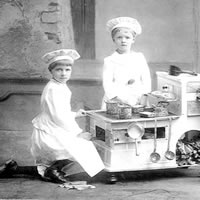| ||||||||||||||||||||||||||||||||||||||||||||||||


The Dithmarscher Cuisine - a reflective image of the landscape
 The
district of Dithmarsch lies on the western coast of Schleswig-Holstein and is
characterised - as is the landscapes across wide areas the northern German lowlands
- by coastal moorlands (the "Geest"), marshes (the "Marsch")
and peat bogs. All these landscapes and their manifold characteristics have had
their influence on the regional cuisine.
The
district of Dithmarsch lies on the western coast of Schleswig-Holstein and is
characterised - as is the landscapes across wide areas the northern German lowlands
- by coastal moorlands (the "Geest"), marshes (the "Marsch")
and peat bogs. All these landscapes and their manifold characteristics have had
their influence on the regional cuisine.- The "Geest" is a landscape of hills and valleys, depressions and high bogs, forests and heaths, fields and hedgerows. It was formed by the last Ice Ages, colonised by plants and animals and later seized by man, who greatly transformed the land.
- The "Marsch" is a young landscape, which was only claimed from
the sea in the last thousand years. At first this process was solely natural;
later it was accelerated and optimised by man. It is a structured landscape,
crossed by uncountable trenches, which boasts heavy, fertile soils. Raised
settlements and houses and polders enclosed by dykes are typical features
for this landscape. The "Watt" - a unique transitional mudflat between
the land and the North Sea - sides the "Marsch" along the coast.
There are depressions, which formed cut-off freshwater coastal lagoons and have in the mean time often turned into wetlands, peat bogs and moist meadows. - All these land forms are closely linked to one another and make up the natural landscape unit of Dithmarschen and are thus the basis for the agricultural activities and the culinary components in the region.
About 60% of the agricultural land is pasture, while the other 40% are used as crop land. The cattle grazing industry of the Dithmarschen area, which is supported by feed crops on the "Geest", make up a fifth of the total cattle industry in Schleswig-Holstein. More than 3000 enterprises cultivate around 110 thousand ha of agricultural land. Most of these farms manage between 30 and 50 ha. Forestry is only marginally important and the small coastal fishing industry centres around the ports of Büsum and Friedrichskoog.
The Dithmarsch cuisine is hearty and often quite fatty. The reason for this most likely lies in the hard working conditions which the inhabitants endured in the past. An interesting taste - which is unusual for many strangers to the area - is the combination of sweet and tangy or acerbic elements in meals. Some examples are „Birnen-Bohnen-Speck im Teig" (pears, beans and bacon in dough), the typical „Mehlbüddel" with a mustard-cherry sauce and Schweinebacke, and „Schwarzsauer" (meaning black-sour) a soup with hog blood. This last meal also shows how the complete animal was used to prepare meals in the past.
The main live stock - sheep and cattle - are not only the most important meats used for meals in the region (lamb is a favourite), but naturally also influence the offering of dairy products and cheese. Today however, only very few small cheese dairies remain in the region, for example in Sarzbüttel.
A variety fish and crab meals are also important constituents of the Dithmarsch
cuisine. Beside the coastal fishery, farming freshwater fish, namely carp and
trout in large ponds in the "Geest" is quite important.
Both cereal and vegetable crops are farmed in both the "Marsch" and
the "Geest", depending on the local soils. A very typical vegetable
is cabbage in its numerous varieties, which has been cultivated since the 19th
century. A large portion of Germany's Sauerkraut is grown and produced in Dithmarschen.
A rare vegetable specialty is "Röhrkohl" and "Queller". Both only grow in the "Watt" or salt meadows outside the dykes and thus have a very salty but tasty flavour. Since they only produce small yields, both are not very important economically and only of qualitative importance in the Dithmarsch cuisine.
In winter, after the first frosts, "Grünkohl", a dark green cabbage variety, is a favourite meal. It is served with loads of meat, mainly sausages, lightly smokes pork loin - known as Kasseler - and Schweinebacke. Sometimes sweetly glazed fried potatoes are served with "Grünkohl".
To help digest such a hearty and fatty meal, a clear cereal schnapps (sometimes
two, sometimes three…) known as "Klarer Korn" is served. The
favourite alcoholic drink however, is beer brewed in the traditional German
pilsner manner (e.g. in Marne in Dithmarschen). In northern Germany, pilsner
beers are generally quite bitter. While black tea used to be the most important
hot drink, coffee has now taken its place in Dithmarschen as in the whole coastal
North Sea area.
|
|
|
|
